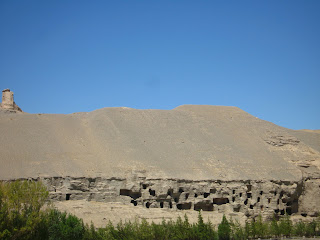 Tourists can't take cameras in, and access to the amazing caves are restricted - out of the 735 caves we were able to go into less than 10. Our guide took us to a good variety of caves, and the tour took 2 hours - though at the end we could have happily wandered through many more.
Tourists can't take cameras in, and access to the amazing caves are restricted - out of the 735 caves we were able to go into less than 10. Our guide took us to a good variety of caves, and the tour took 2 hours - though at the end we could have happily wandered through many more.The first cave we went into housed the Big Buddha - which at 34.5m high is one of the largest in the world - housed in this 9 story pagoda-like structure:
 All the caves we went into were from different periods of time between the 4th and 13th Centuries, and were funded by individuals including merchants of the Silk Road, monks, and officials. Most caves had Buddhist frescoes on the walls, some of which had been scratched off, re-clayed and then new pictures repainted by people who wanted to contribute to the caves, but lacked space to do so! Lots of the caves also had real gold used in the artwork - one cave that stood out had a thousand painted Buddhas, but only one with a gold face.
All the caves we went into were from different periods of time between the 4th and 13th Centuries, and were funded by individuals including merchants of the Silk Road, monks, and officials. Most caves had Buddhist frescoes on the walls, some of which had been scratched off, re-clayed and then new pictures repainted by people who wanted to contribute to the caves, but lacked space to do so! Lots of the caves also had real gold used in the artwork - one cave that stood out had a thousand painted Buddhas, but only one with a gold face.Another cave that caught our attention was one with significant Indian influence, where we followed an old Buddhist story that lined the walls about how the Buddha (in a previous life) sacrificed his body for starving tigers.
The final cave we saw was the Library Cave where in 1900 a secret cave was discovered that had thousands of manuscripts hidden away (including the world's oldest book, medical prescriptions, music, and military reports). In 1907 European adventurers managed to pay a very little price for a lot of these manuscripts (a fact repeated to us many times, as if to make us feel guilty, by our guide), and these days are found in many museums around the world.
Afterwards we went to the museum where several caves we didn't see are reproduced - it was amazing to see how realistic and old they managed to make them.
 As we couldn't take photos in the real caves, these are a couple from inside the pretend ones:
As we couldn't take photos in the real caves, these are a couple from inside the pretend ones:
After hiding our from the near 40 degrees heat till about 5pm (though it was still in the 30's when we ventured out) we eventually headed to Mingsha Shan (Singing Sands Mountain), which is a huge stretch of mammoth sand dunes.



On the way home we passed camels being led by motorbike / bicylce back to their homes, and sneakily picked ourselves a fresh pear! All in all the dunes turned out to be a worthwhile and cheaply adlibed adventure.
Adlibing it to the end of the fence.





1 comment:
so good
Post a Comment